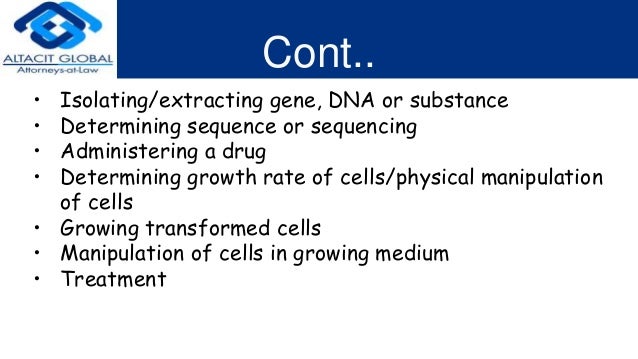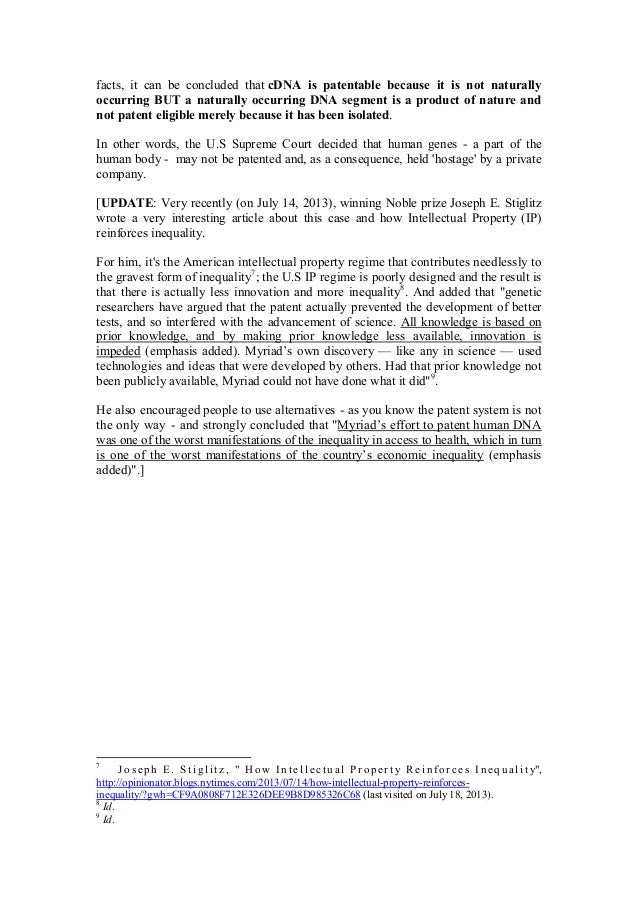

The Court distinguished Myriad from Diamond v. at 10, the Supreme Court has “long held that contains an important implicit exception Laws of nature, natural phenomena, and abstract ideas are not patentable,” id. composition of matter, or any new and useful improvement thereof, may obtain a patent,” id. § 101.Īfter explaining the fundamental molecular genetics of protein expression, the Supreme Court found that “separating gene from its surrounding genetic material is not an act of invention” deserving of patent protection. At each stage, the courts wrestled with whether “naturally occurring” DNA is patent eligible under 35 U.S.C. The case made its way to the Federal Circuit, the Supreme Court, and back to the Federal Circuit before oral arguments were heard before the Supreme Court again earlier this year. Medical patients, advocacy groups, and doctors originally filed a declaratory judgment action against Myriad in the United States District Court for the Southern District of New York (“ S.D.N.Y.”) in 2009, asserting the invalidity of its claims to the BRCA genes. Additionally, Myriad claimed all DNA and cDNA sequences having at least 15 of the nucleotides of the DNA and cDNA sequences listed in Claim 1 and Claim 2. cDNA is synthetically created in a lab and does not exist naturally. Unlike naturally occurring DNA, which contains both coding regions (“exons”) and non-coding regions (“introns”), cDNA lacks introns. Myriad also claimed complementary DNA (“cDNA”) corresponding to the same gene (“Claim 2”). In three of its patents, Myriad claimed “isolated DNA” corresponding the BRCA1 gene (“Claim 1”). Myriad obtained several patents based on its discovery of the BRCA genes’ locations, giving it the exclusive rights to isolate any individual’s BRCA genes and to make diagnostic testing kits based on those genes. The nucleotides-basic molecular building blocks of DNA-at either end of a gene demarcate its “precise location” in a strand of DNA. Genes occupy distinct segments of DNA molecules. (“Myriad”) discovered the “precise location and sequence of two human genes,” BRCA1 and BRCA2, “mutations of which can substantially increase the risks of breast and ovarian cancer.” Id. JDSupra highlights the narrowness of the holding and the Supreme Court’s failure to clarify the bounds of patentable subject matter under 35 U.S.C. Professor Paul Cole, writing for Patently-O, discusses the mismatch between the Supreme Court’s holding and the international consensus on the patentability of isolated DNA. The Court thus affirmed in part and reversed in part the Court of Appeals for the Federal Circuit’s prior opinion upholding the patent eligibility of isolated DNA.īloomberg provides perspectives from groups with a special interest in the case-including the ACLU, university researchers, diagnostic testing companies, the Biotechnology Industry Organization, and Angelia Jolie-and speculates on the impact of the opinion on personalized medicine. However, “cDNA is patent eligible because it is not naturally occurring.” Id.

In a unanimous decision, the Supreme Court held that “a naturally occurring DNA segment is a product of nature and not patent eligible merely because it has been isolated.” Ass’n for Molecular Pathology v. Myriad Geneticsīy Alex Shank – Edited by Kathleen McGuinnessĪss’n for Molecular Pathology v. What will the Court’s decision hold for a field where thousands of gene patents have already been secured? Do such patents inhibit or promote further such discoveries, or is the evidence clear? On this previously recorded conference call, our expert, who attended the oral argument, discusses and provides his thoughts on the case and answers questions from callers.Patent Ass’n for Molecular Pathology v. The challengers claim that Myriad Genetics has created nothing new, but rather the process is an examination of a substance found in nature whose attributes remain unchanged.
PATHOLOGY VS MYRIAD GENETICS CODE
Myriad Genetics, which identified two sections of the genetic code that might indicate higher risk for certain types of cancer, obtained patents on the "isolated" or removed versions of these two genes on the basis that Myriad invented a new chemical in the process of identifying and removing these genes from the body. Myriad Genetics, Inc, concerning whether human genes can be patented. On Monday, April 15, the Supreme Court heard oral argument in a patents case, Association for Molecular Pathology v.


 0 kommentar(er)
0 kommentar(er)
